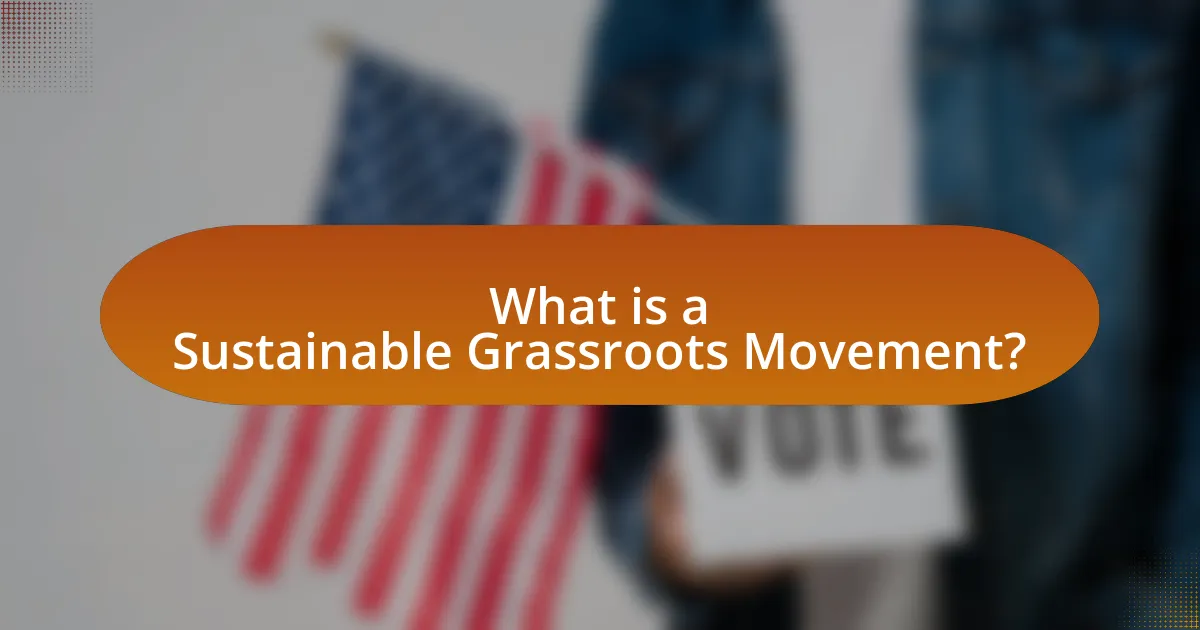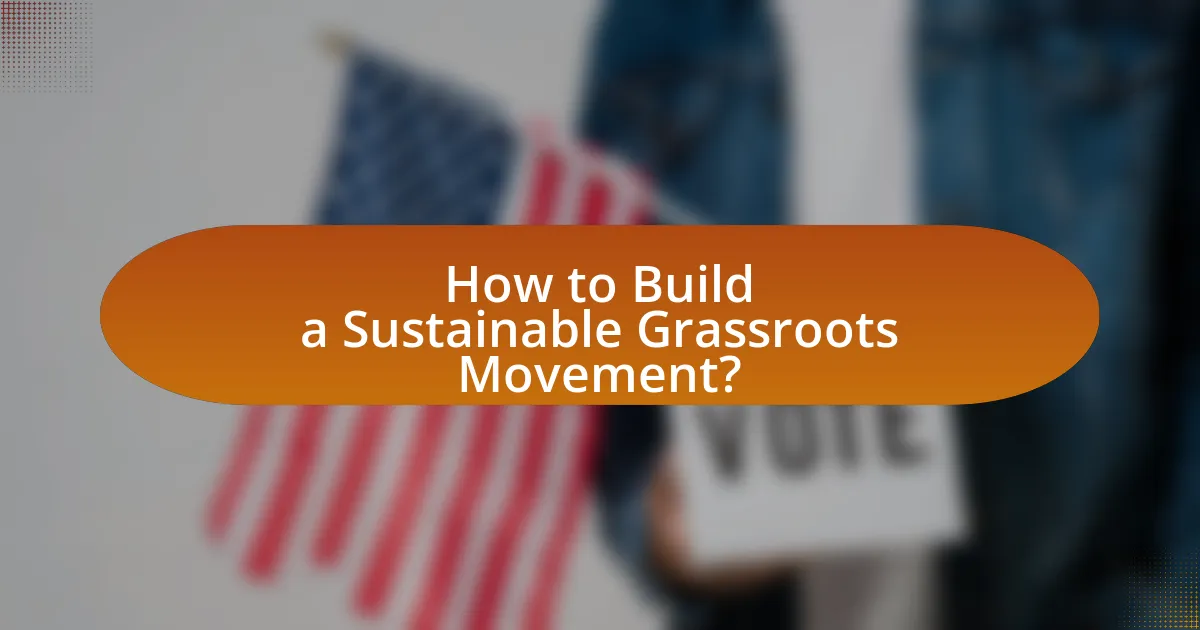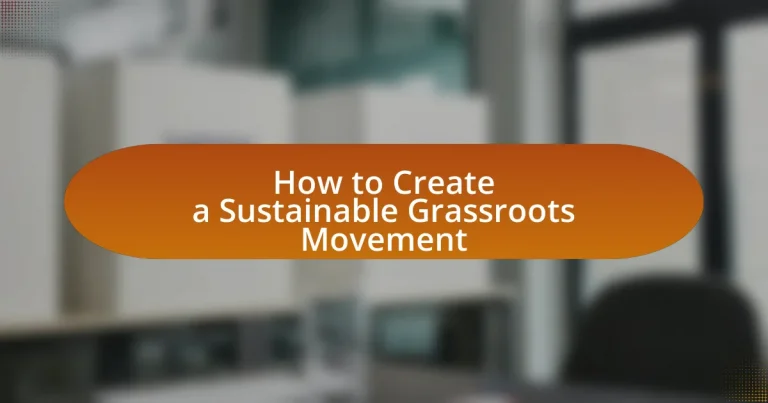A sustainable grassroots movement is a community-driven initiative aimed at achieving long-term social, environmental, or political change through local engagement. This article outlines the characteristics that differentiate grassroots movements from traditional movements, emphasizing their bottom-up approach, inclusivity, and community empowerment. Key principles for sustainability, such as adaptability and transparency, are discussed alongside the challenges these movements face, including resource limitations and resistance from established systems. Strategies for building and maintaining a grassroots movement, including effective communication, partnerships, and volunteer engagement, are also explored, providing a comprehensive framework for fostering impactful and enduring community initiatives.

What is a Sustainable Grassroots Movement?
A sustainable grassroots movement is a community-driven initiative that seeks to create long-term social, environmental, or political change through local engagement and participation. These movements often focus on empowering individuals and communities to address issues that directly affect them, fostering a sense of ownership and responsibility. For example, the environmental justice movement has successfully mobilized communities to advocate for cleaner air and water, demonstrating the effectiveness of grassroots efforts in achieving sustainable outcomes.
How does a grassroots movement differ from traditional movements?
A grassroots movement differs from traditional movements primarily in its bottom-up approach, where ordinary individuals mobilize to effect change, rather than relying on established institutions or leaders. Grassroots movements often emerge spontaneously from community needs and are characterized by decentralized organization, emphasizing local participation and direct action. In contrast, traditional movements typically involve hierarchical structures, formal leadership, and established political channels. For example, the Civil Rights Movement in the United States included both grassroots efforts, like local sit-ins and protests, and traditional elements, such as organized campaigns led by prominent figures. This distinction highlights how grassroots movements prioritize community engagement and collective action over top-down directives.
What are the key characteristics of grassroots movements?
Grassroots movements are characterized by their community-driven nature, emphasizing local participation and leadership. These movements typically arise from the collective efforts of individuals who share common interests or grievances, often mobilizing around social, political, or environmental issues. They rely on grassroots organizing strategies, such as community meetings, social media campaigns, and direct action, to engage and empower members. Additionally, grassroots movements often prioritize inclusivity and diversity, ensuring that marginalized voices are heard and represented. Historical examples, such as the Civil Rights Movement in the United States, illustrate how grassroots efforts can lead to significant social change, demonstrating the effectiveness of local activism in challenging systemic injustices.
Why is sustainability important in grassroots movements?
Sustainability is crucial in grassroots movements because it ensures long-term viability and effectiveness in achieving social change. Grassroots movements often rely on community engagement and local resources, making sustainable practices essential for maintaining momentum and support. For instance, a study by the Stanford Social Innovation Review highlights that sustainable grassroots initiatives can foster deeper community ties and enhance participation, leading to more impactful outcomes. By prioritizing sustainability, these movements can adapt to challenges, secure ongoing funding, and create lasting change within their communities.
What are the foundational principles of a sustainable grassroots movement?
The foundational principles of a sustainable grassroots movement include community engagement, inclusivity, empowerment, and adaptability. Community engagement ensures that the movement is rooted in the needs and aspirations of local individuals, fostering a sense of ownership and responsibility. Inclusivity promotes diverse participation, allowing various voices and perspectives to shape the movement’s direction, which enhances its legitimacy and effectiveness. Empowerment focuses on equipping individuals with the skills and resources necessary to take action, thereby building local leadership and resilience. Lastly, adaptability allows the movement to respond to changing circumstances and challenges, ensuring its longevity and relevance. These principles are supported by successful case studies, such as the Civil Rights Movement, which thrived on community involvement and adaptability to societal changes.
How do community engagement and participation shape these principles?
Community engagement and participation significantly shape the principles of creating a sustainable grassroots movement by fostering inclusivity and ensuring that the movement reflects the needs and values of the community. When community members actively participate, they contribute diverse perspectives that inform the movement’s goals and strategies, leading to more effective and relevant initiatives. Research indicates that grassroots movements with high levels of community involvement are more likely to achieve long-term success, as evidenced by the success of the Civil Rights Movement, which relied heavily on community mobilization and participation to drive systemic change. This active engagement not only empowers individuals but also builds trust and solidarity within the community, reinforcing the movement’s foundational principles.
What role does transparency play in building trust within the movement?
Transparency is essential in building trust within a grassroots movement as it fosters open communication and accountability among members. When leaders and participants share information about decision-making processes, resource allocation, and organizational goals, it creates an environment where individuals feel valued and informed. Research indicates that movements with high levels of transparency experience increased engagement and loyalty from their supporters, as evidenced by the success of various social movements that prioritized clear communication and ethical practices. For instance, the Black Lives Matter movement has effectively utilized transparency in its operations, which has contributed to its widespread support and trust among diverse communities.
What challenges do grassroots movements face in achieving sustainability?
Grassroots movements face several challenges in achieving sustainability, primarily including limited funding, lack of political support, and difficulties in scaling their initiatives. Limited funding restricts the ability of these movements to implement long-term projects, as many rely on small donations or volunteer efforts. According to a report by the Grassroots Fundraising Journal, over 70% of grassroots organizations report financial constraints as a significant barrier to their sustainability. Additionally, lack of political support can hinder their efforts, as policies may not align with grassroots objectives, making it difficult to influence systemic change. Furthermore, scaling initiatives poses a challenge, as successful local efforts often struggle to replicate their models in different contexts, leading to inconsistent impact. These factors collectively impede the long-term viability and effectiveness of grassroots movements in promoting sustainable practices.
How can resource limitations impact the effectiveness of a grassroots movement?
Resource limitations can significantly hinder the effectiveness of a grassroots movement by restricting its ability to mobilize supporters, communicate messages, and implement initiatives. When financial resources are scarce, grassroots organizations struggle to fund essential activities such as outreach, event organization, and advocacy campaigns, which are crucial for building momentum and visibility. For instance, a study by the National Council of Nonprofits highlights that organizations with limited budgets often face challenges in hiring skilled staff or securing necessary materials, leading to reduced operational capacity and outreach effectiveness. Additionally, without adequate resources, grassroots movements may lack the technological tools needed for effective communication and coordination, further diminishing their impact in rallying community support and achieving their goals.
What strategies can be employed to overcome resistance from established systems?
To overcome resistance from established systems, grassroots movements can employ strategies such as building coalitions, leveraging data-driven advocacy, and engaging in effective communication. Building coalitions with diverse stakeholders enhances credibility and broadens support, as seen in the successful collaboration of environmental groups during the Paris Agreement negotiations. Leveraging data-driven advocacy involves using research and statistics to present compelling arguments that highlight the benefits of proposed changes, which can sway public opinion and policymakers. Effective communication, including storytelling and framing issues in relatable terms, helps to resonate with the target audience and counteract negative narratives. These strategies have been proven effective in various movements, demonstrating their validity in overcoming systemic resistance.
How can grassroots movements ensure long-term impact?
Grassroots movements can ensure long-term impact by building strong community engagement and fostering leadership development. Engaging the community creates a sense of ownership and accountability, which is essential for sustainability. For instance, the Civil Rights Movement in the United States effectively mobilized local communities, leading to significant legislative changes that have had lasting effects on civil rights. Additionally, developing leaders within the movement empowers individuals to continue advocacy efforts, as seen in the environmental movement where local leaders have driven policy changes at various levels. This combination of community involvement and leadership cultivation is crucial for maintaining momentum and achieving enduring results.
What role does leadership play in sustaining a grassroots movement?
Leadership is crucial in sustaining a grassroots movement as it provides direction, motivation, and organization. Effective leaders inspire participants, foster a sense of community, and articulate a clear vision that aligns with the movement’s goals. For instance, leaders like Martin Luther King Jr. galvanized support for the Civil Rights Movement by effectively communicating the movement’s objectives and mobilizing grassroots efforts. Research indicates that strong leadership correlates with increased engagement and retention of volunteers, which is essential for the longevity of grassroots initiatives.

How to Build a Sustainable Grassroots Movement?
To build a sustainable grassroots movement, start by establishing a clear mission and vision that resonates with the community. This clarity helps to unify supporters and attract new members. Engaging the community through regular meetings, outreach programs, and social media campaigns fosters a sense of belonging and encourages participation.
Additionally, forming partnerships with local organizations and leveraging existing networks can amplify efforts and resources. Research indicates that grassroots movements with strong community ties and collaborative strategies are more likely to sustain momentum over time. For example, the Civil Rights Movement in the United States effectively mobilized local communities through organized efforts and clear messaging, leading to significant social change.
Finally, continuously evaluating the movement’s impact and adapting strategies based on feedback ensures relevance and effectiveness, which are crucial for long-term sustainability.
What steps are essential for initiating a grassroots movement?
To initiate a grassroots movement, the essential steps include identifying a clear cause, building a coalition of supporters, developing a strategic plan, and utilizing effective communication channels. Identifying a clear cause provides a focused objective that resonates with potential supporters, while building a coalition involves recruiting individuals and organizations that share the same vision, thereby amplifying the movement’s reach and impact. Developing a strategic plan outlines specific goals, actions, and timelines, ensuring organized efforts toward achieving the movement’s objectives. Finally, utilizing effective communication channels, such as social media and community events, facilitates outreach and engagement, fostering a sense of community and shared purpose among supporters. These steps are validated by successful grassroots movements like the Civil Rights Movement, which effectively mobilized communities through clear objectives and strategic planning.
How do you identify and mobilize community members?
To identify and mobilize community members, conduct outreach through surveys, community meetings, and social media engagement to assess interests and needs. This approach allows for the collection of data on community demographics and priorities, which can be analyzed to identify key stakeholders and potential leaders. For instance, a study by the National Civic League highlights that effective community engagement strategies can increase participation rates by up to 50%. Once identified, mobilization can occur through targeted communication, organizing events, and creating collaborative projects that align with the community’s interests, fostering a sense of ownership and commitment among members.
What methods can be used to raise awareness and support?
To raise awareness and support for a grassroots movement, effective methods include social media campaigns, community events, and partnerships with local organizations. Social media campaigns leverage platforms like Facebook and Twitter to disseminate information quickly, reaching a broad audience; for instance, studies show that social media can increase engagement by up to 60%. Community events, such as workshops or rallies, foster direct interaction and build local support, evidenced by the success of initiatives like the Women’s March, which mobilized millions globally. Collaborating with local organizations enhances credibility and resource sharing, as demonstrated by the partnership between the Sierra Club and various community groups to promote environmental awareness.
How can grassroots movements effectively utilize social media?
Grassroots movements can effectively utilize social media by creating targeted campaigns that engage their audience and foster community involvement. By leveraging platforms like Facebook, Twitter, and Instagram, these movements can disseminate information quickly, mobilize supporters, and amplify their message to a broader audience. For instance, the #MeToo movement gained significant traction through social media, allowing individuals to share their stories and connect with others, which led to widespread awareness and advocacy for change. Additionally, social media analytics can help grassroots organizations understand their audience better, tailor their messaging, and measure the impact of their campaigns, thereby enhancing their overall effectiveness.
What platforms are most beneficial for grassroots organizing?
Social media platforms, particularly Facebook, Twitter, and Instagram, are most beneficial for grassroots organizing. These platforms enable rapid communication, community building, and mobilization of supporters. For instance, Facebook allows for the creation of event pages and groups, facilitating organization and outreach to large audiences. Twitter’s real-time updates and hashtags help amplify messages and connect with broader movements. Instagram’s visual storytelling engages users effectively, making it easier to share impactful narratives and mobilize action. According to a study by the Pew Research Center, 69% of adults in the U.S. use Facebook, highlighting its potential reach for grassroots initiatives.
How can storytelling enhance engagement and support?
Storytelling enhances engagement and support by creating emotional connections that resonate with audiences. When narratives are shared, they evoke empathy and foster a sense of belonging, which is crucial for grassroots movements. Research indicates that stories can increase information retention by up to 65%, making the message more impactful. Additionally, storytelling can illustrate the mission and values of a movement, helping to mobilize individuals around a common cause. This approach not only captures attention but also encourages participation, as people are more likely to support initiatives that they feel personally connected to.
What partnerships are crucial for a sustainable grassroots movement?
Crucial partnerships for a sustainable grassroots movement include collaborations with local organizations, community leaders, and relevant stakeholders. Local organizations provide essential resources and networks that enhance outreach and engagement, while community leaders lend credibility and influence, helping to mobilize support. Additionally, partnerships with stakeholders such as government agencies and businesses can secure funding and resources, further strengthening the movement’s impact. Research indicates that grassroots movements with strong local partnerships are more likely to achieve long-term sustainability and effectiveness, as evidenced by successful initiatives like the Community Organizing and Family Issues (COFI) program, which demonstrated increased community engagement through strategic partnerships.
How can collaborations with local organizations strengthen the movement?
Collaborations with local organizations can strengthen the movement by leveraging their established networks and resources to enhance outreach and engagement. Local organizations often possess deep community ties, which can facilitate trust and credibility, essential for mobilizing support. For instance, a study by the National Council of Nonprofits highlights that partnerships with local entities can increase participation rates by up to 50%, as these organizations can effectively communicate the movement’s goals to their constituents. Additionally, local organizations can provide valuable insights into community needs and preferences, ensuring that the movement’s initiatives are relevant and impactful.
What role do volunteers play in sustaining momentum?
Volunteers play a crucial role in sustaining momentum by providing essential support, resources, and community engagement. Their involvement fosters a sense of ownership and commitment among participants, which is vital for maintaining enthusiasm and activity levels within grassroots movements. Research indicates that volunteer-driven initiatives often experience higher retention rates and increased participation, as volunteers help to mobilize others and spread awareness. For instance, a study by the Corporation for National and Community Service found that communities with active volunteer programs saw a 20% increase in civic engagement, demonstrating the direct impact of volunteers on sustaining momentum in grassroots efforts.

What Best Practices Should Be Followed for Sustainability?
Best practices for sustainability include reducing waste, conserving energy, and promoting renewable resources. Organizations should implement recycling programs to minimize landfill contributions, which can significantly decrease environmental impact. For instance, the Environmental Protection Agency (EPA) reports that recycling and composting prevented the release of 186 million metric tons of carbon dioxide equivalent into the air in 2018. Additionally, adopting energy-efficient technologies can lower energy consumption; the U.S. Department of Energy states that energy-efficient appliances can reduce energy use by 10-50%. Promoting the use of renewable resources, such as solar and wind energy, further supports sustainability by decreasing reliance on fossil fuels, which are a major contributor to climate change.
How can grassroots movements measure their impact?
Grassroots movements can measure their impact through quantitative and qualitative metrics, such as tracking membership growth, engagement levels, and policy changes influenced by their efforts. For instance, a movement can analyze the number of participants in events or campaigns, which provides a clear indication of community involvement and support. Additionally, surveys and interviews can capture personal stories and testimonials that reflect the movement’s influence on individuals and communities. Research shows that movements that effectively document their achievements, such as changes in legislation or increased public awareness, can demonstrate their success more convincingly. For example, the Women’s March in 2017 reported over 4 million participants across the United States, showcasing its significant mobilization and impact on public discourse regarding women’s rights.
What metrics are useful for evaluating success?
Key metrics for evaluating success in a grassroots movement include engagement levels, fundraising totals, membership growth, and policy impact. Engagement levels can be measured through participation in events, social media interactions, and volunteer hours, indicating community involvement and support. Fundraising totals reflect financial sustainability and the ability to support initiatives, while membership growth shows the movement’s reach and appeal. Policy impact can be assessed by tracking changes in legislation or community practices influenced by the movement, demonstrating tangible outcomes. These metrics collectively provide a comprehensive view of a grassroots movement’s effectiveness and sustainability.
How can feedback be incorporated to improve strategies?
Feedback can be incorporated to improve strategies by systematically collecting, analyzing, and implementing insights from stakeholders. This process involves creating channels for open communication, such as surveys or focus groups, to gather diverse perspectives on current strategies. For instance, organizations that actively solicit feedback from community members often identify gaps in their approach, leading to more effective engagement and resource allocation. Research shows that organizations that adapt their strategies based on stakeholder feedback can increase participation rates by up to 30%, demonstrating the tangible benefits of this practice.
What are some common pitfalls to avoid in grassroots movements?
Common pitfalls to avoid in grassroots movements include lack of clear goals, insufficient community engagement, and failure to build a diverse coalition. Clear goals are essential; without them, movements can lose direction and purpose, leading to disorganization. Insufficient community engagement can result in a disconnect between leaders and the community, diminishing support and participation. Additionally, failing to build a diverse coalition can limit perspectives and resources, weakening the movement’s impact. Research indicates that inclusive movements are more successful; for example, the Women’s March in 2017 demonstrated the power of diverse participation in achieving significant visibility and influence.
How can over-reliance on a few leaders hinder sustainability?
Over-reliance on a few leaders can hinder sustainability by creating a bottleneck in decision-making and limiting diverse input. When leadership is concentrated, the movement may become overly dependent on the vision and capabilities of a small group, which can stifle innovation and adaptability. For instance, research indicates that organizations with distributed leadership models are more resilient and better equipped to respond to challenges, as they benefit from a wider range of perspectives and skills. This lack of diversity in leadership can lead to burnout among those few leaders, resulting in a potential collapse of the movement if they leave or become ineffective.
What strategies can prevent burnout among volunteers and leaders?
To prevent burnout among volunteers and leaders, organizations should implement strategies such as setting clear expectations, providing adequate training, and fostering a supportive community. Clear expectations help volunteers understand their roles and responsibilities, reducing confusion and stress. Adequate training equips volunteers with the necessary skills, enhancing their confidence and effectiveness. Fostering a supportive community encourages open communication and collaboration, which can alleviate feelings of isolation and overwhelm. Research indicates that organizations with strong support systems experience lower burnout rates, as volunteers feel valued and connected to their mission.
What practical tips can help maintain a sustainable grassroots movement?
To maintain a sustainable grassroots movement, it is essential to foster strong community engagement and build a diverse coalition of supporters. Engaging the community ensures that the movement reflects the needs and values of its members, which can be achieved through regular meetings, open forums, and feedback mechanisms. Building a diverse coalition enhances the movement’s resilience and reach, as it brings together individuals with varied skills, perspectives, and networks. Research indicates that movements with diverse participation are more likely to succeed in achieving their goals, as they can mobilize a broader base of support and resources. Additionally, establishing clear goals and maintaining transparent communication helps keep members motivated and aligned with the movement’s mission.


